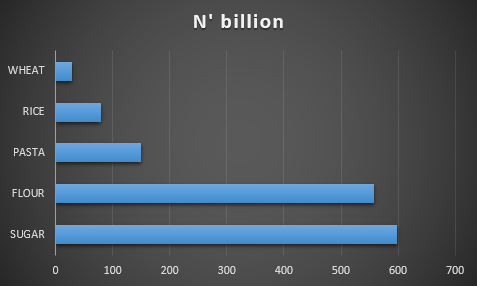|
Listen now
Getting your Trinity Audio player ready...
|
BUA Foods, Nigeria’s largest listed firm with a market capitalization of N12.46 trillion (November 03, 2025) is growing fast and understanding the drivers behind this valuation requires a close examination of its revenue composition.
The Fast Moving Consumer Goods (FMCG) giant’s revenue was up 32.71 percent to N1.42 trillion in the 9-months period to September 2025, from N1.07 trillion as at September 2024.
The company operates across various segments, primarily manufacturing, processing, and distributing food products across the Fast-Moving Consumer Goods (FMCG) sector.
Overview of Major Revenue Streams
BUA Foods’ revenue is broadly categorized into five core product lines. For the period leading up to Q3 2025, the following segments are the primary contributors to its top line:
Sugar Segment (Refined and Packaged)
This is historically BUA Foods’ most dominant revenue stream and typically accounts for the largest share of the total turnover.
· Key Products: Refined granulated sugar sold to industrial clients (bottlers, confectioners) and packaged sugar sold directly to consumers.
· Driver: High domestic demand and continuous capacity expansion through its Backward Integration Program (BIP). This segment benefits heavily from government policies limiting sugar importation.
BUA Foods recorded total Sugar sales of N598 billion, comprising fortified (N451.69 billion) and non-fortified (N146.65 billion) sugar as at 9 months 2025.
Total sugar sales were up 9.9% compared to N543.7 billion as at September 2024.
Flour Segment
The flour division represents a significant and growing portion of BUA Foods business, essential for the baking and food processing industries.
Key Products are various grades of wheat flour, and growth drivers are consistent demand from small and medium-sized bakeries and industrial food manufacturers, alongside improved production efficiency from its mills.
Total Flour sales amounted to N556.86 billion as at September 2025, up 45% compared to the September 2024 period.
Pasta Segment
The pasta business of BUA Foods provides a crucial diversification engine, offering popular staple food products across Nigeria.
Key Products: Semolina and various shapes of dry pasta.
Driver: Rapid urbanization, changing consumption patterns, and BUA’s aggressive market penetration strategies offering competitive pricing and quality.
Total Pasta sales were N150.49 billion as at September 2025, up 11.6% from a year ago.
Rice Segment
While sugar, flour, and pasta have traditionally led, BUA Foods has made strategic investments into large-scale rice farming and milling, positioning this as a key future growth contributor.
Key Products: Locally grown and milled rice.
Driver: Strong push toward local rice self-sufficiency in Nigeria, making this a high-potential growth segment, albeit still smaller than sugar and flour.
BUA Foods’ Rice segment delivered stellar 4,900% growth to N79.5 billion in total revenue (comprising Head Rice, Paddy and Rice Bran) as at September 2025, up from N1.59 billion in the 2024 period.
Wheat Bran
This new product line delivered N28.32 billion in revenue for BUA Foods in September 2025, up from zero as at September 2024.
Financial Stability and Strategic Focus
BUA Foods’ ability to maintain its market position is validated by its strong integration across the value chain, from sourcing raw materials (Backward Integration) to processing and distribution.
This strategy helps mitigate foreign exchange volatility, which is a significant factor in the Nigerian market, and stabilizes the cost of goods sold (COGS), allowing it to translate high revenue figures into consistent profitability.




 Follow the MoneyCentral Nigeria channel on WhatsApp: Click here!
Follow the MoneyCentral Nigeria channel on WhatsApp: Click here!